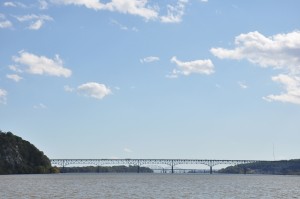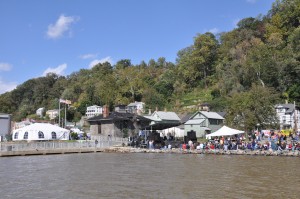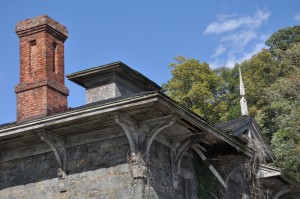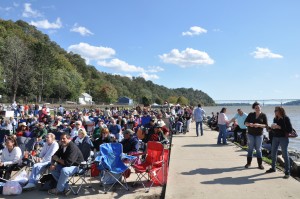Whitecaps foamed on brown Susquehanna waters and gusting winds snatched at tickets and threatened the frame tents sheltering crafts people and food vendors. It was only a little past noon and already Deesigns by Deena was packing up. Necklaces with cross-sections of nautilus fossils, freshwater pearls, crystals, and all kinds of stones—I snatched a business card and longingly examined the few pieces left out. My Dear One found a tiny sculpted crab, cast in recycled pewter and with pincers outstretched toward a nacreous teardrop, and placed it around my neck.
The day’s main attraction was a performance by country-music star George Jones. Hurricane Irene preempted the event in September and some of the town’s residents are likely still cleaning basements, repairing foundations and replacing carpets and appliances inundated a month ago.
It’s an odd little burg, is Port Deposit, Maryland. Originally a collection point for lumber floated down the river, it became a key trading location as it was the furthest point downstream on the Susquehanna and the farthest point north in the Chesapeake Bay accessible by boats. Inland quarries produced granite used in buildings up and down the East Coast. Late 19th and early 20thcentury houses, some stone and many stick cottages with steeply pitched roofs, carved finials and lovely ornament, and many with verandas across the front are separated from the main thoroughfare by a narrow sidewalk. On the western side of the street, the CSX railroad tracks run between houses and the river. Across the way, the hill rises precipitously behind homes and low terraces crawl up the hillside alongside rock outcroppings and the remains of old foundations. Port Deposit is also the site of the Bainbridge Naval Training Center, abandoned in 1976.
Yellow school buses shuttled us from parking areas on the outskirts of town to the Marina Park, a narrow strip of land that abuts the derelict train station and includes access to a modern fishing pier. We wandered here and there, bought a pit-beef sandwich for lunch and washed it down with a bottle of Midnight Red from Legends Vineyard in Harford County. Boordy, Cascia and Fiore Vineyards were also there, all offering tastes of Maryland grape.
By midafternoon, we shifted to the lawn chairs we had left far enough from the stage to buffer us from the bone-shaking volume produced by the bank of amplifiers. We enjoyed the last of the Midnight Red, read, and watched two trains roll through, one a chain of tanks filled with liquid gas probably fracked from shale deposits in Pennsylvania. Bands followed one another on stage, some more country, some more rock-and-roll.
The winds eased a little, but the American and Maryland State flags still were held horizontal by the breeze. The sun eased downward, its heat radiating against my face and along the sides of my bluejeaned legs. The sky was brilliant blue above the hillside to the east and faded to haze in the west where a few tiny puffs of cloud hovered just above the Harford County shoreline. George Jones took the stage and the crowd roared with delight. He was not feeling his best; sinusitis and a sore throat hampered his sound but not his desire to perform. He sang the “cheatin’ and drinkin’ ” songs the crowd was there to hear, white hair silver in the sun, black patterned jacket both Nashville-glitzy and elegant, dimples and smile as sexy as ever. Jones turned 81 a month ago and poked gentle fun at his age, offering his handsome and talented 25-year-old fiddle player to the screaming girls who lined the edge of the stage.
It was a good long set, about ninety minutes. As he launched into his finale, I was walking back toward the buses, happy to have that moment of music and solitude, in the warmth of the sun and the cool of the wind.
George Jones sang, “I don’t need no rockin’ chair.”
He probably doesn’t. On a day like that, though, I could sit and rock forever.






